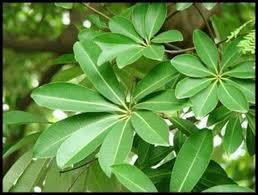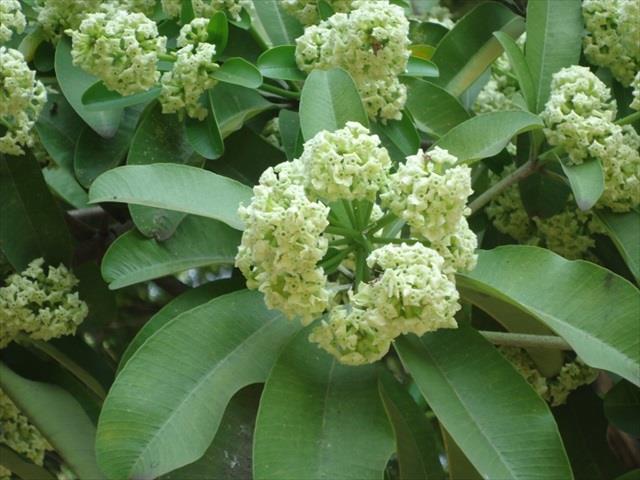SAPTAPARNA
Contents
· Introduction
· Description of the tree
· Puranic Reference
· Ayurvedic References
· Significance
Introduction

Saptaparna means a plant which bears leaves in clusters of 4-7 leaves. The other synonyms of Saptaparna in Sanskrit are Saptaparni, Sarada, Vishalalvaka, Vishamachhda, Ayugmaparna, Gandhiparna, Payasya, Jivani, Kshalrya, Madagandha, Grahashi and Grahanashana.
The vernacular names are Chatiar (Assamese), Chhatim (Bengali), Chatian, SaIni chatian (Hindi) Saptaparna, Maddale, Kodale, Elele kale, Janthalla Hale (Kannada), Ezhilampala, Mukkampala, Pala (Malayalam), Salvin (Marathi), Satona (Punjabi), Elilaipillai (Tamil) Eda kula, Pala garuda (Telegu). In English, it is known as the Indian Devil Tree, Scholar’s tree, Devil tree, Blackboard tree, Dita bark, Milkwood pine and White cheesewood. The botanical name is Alstonia scholaris and belongs to the family of Apocynaceae (Nerium family).

Description of the tree
Saptaparna is an evergreen tree which grows to a height of 40- 50 mts and is spreading. The tree grows naturally in any type of soil including arid regions. Its leaves green in colour, appear glossy on the upper side, while the underside of the leaves appear greyish in colour. Leaves are 4- 6 inches in length, and 1-2 cms in diameter. The leaves though in clusters are of uneven size known as visama- cchada and ayuk cchada.
The aromatic flowers are white funnel shaped with a milky sap. The flowering season is from October – November. The tree is found extensively in West Bengal, besides in other parts of India.
The bark is thick, brittle, white on the external surface and yellowish inside. A milky liquid oozes when the bark is cut. The seeds are white in colour have cotton like fibres attached to it at the end. The tree bears fruits in January- February. The tree is native to Asian subcontinent. It is found extensively in India, Pakistan, Nepal, Burma, Bangladesh, Malaysia, Indonesia, Thailand, Philippines and Australia.
Puranic Reference
According to Brahma Purana, the land of Utkal, Orissa is holy. The land is said to bless its people salvation and absolve them of all the sins. The land is one of the rarest holy centres. The land of Utkal contains several sacred trees and one such tree is Saptaparna.
In Buddhism, Saptaparna is known as the Man-plant, meaning seven principled human being.
SaptaParna is also the name of a cave of seven chambers where the Gautama Buddha taught esoteric truths to his select disciples- Arhats. The cave is located near Mount Balibhar, Rajagriha, the ancient capital of Magadha. It is the place where the first Buddhist council was held during the reign of the King Ajatashatru.
In Atharva Veda, it is mentioned that the tree is used in the preventive and curative diseases caused due to seasonal changes.

Ayurvedic Uses
Saptaparna is a traditional herbal plant used in ayurvedic medicinal preparation. There is a mention of the plant in the Charaka and Sushrutha Samhithas. The bark, latex, flowers and leaves are used in the medicinal preparation. The tree is a rich source of alkaloids and flavonoids. The tree is known for its anticancer property.
The medicinal properties of Saptaparna are:
Rasa (taste) -Tikta (bitter), Kashaya (astringent)
Guna (qualities) -Laghu (lightness), Snigdha (unctuousness, oilyness)
Virya -Ushna – hot potency
Vipaka -Katu – undergoes pungent taste conversion after digestion.
The Bark: The bark contains alkaloids, ditamine, echitenine and echitamine. The bark of Saptaparna is bitter, tonic, astringent, expectorant, alterative, anthelmintic, emmenagogue and galactogogue.
Decoction of the stem bark is used in the treatment of colic pain, skin diseases, recurrent fever and urinary infections. It is effective in treating headache, sores, discharge of sperm with the urine, improving breast milk, cold congestion and dyspepsia. Twigs of the tree are hung in the room of a new mother to ward off evil spirits on the new born baby.
The latex is used to treat pimples, pyorrhoea. The latex from the bark is used to treat ulcers. For putrefied (decomposed) wounds, a paste of the bark is an antidote. Bark is used as an alternative to quinine. (A natural white crystalline alkaloid having fever reducing, anti malarial analgesic and anti inflammatory properties) The bark is used in the upper purification process of panchakarma.
A decoction of the bark is used to remove intestinal worms and improve digestion. Bark is effective as a cardiac tonic and used to lower cholesterol levels in the body.
A mixture of the bark boiled in water is given to new mother after delivery, as it is said to boost the immunity levels of the new mother.
Flowers: Flower is used to treat asthma and other respiratory problems. For the treatment of headaches, the flowers are finely powdered and used for nasal administration.
Leaves: A paste of the tender leaves boiled and made into a paste, when applied on external wounds hastens the healing. A decoction of the leaves is used to treat beriberi. The bark and the leaves are used to treat diabetes, earaches, snake bites, chronic dysentery, liver congestion and tooth ache.
The leaves are also used for ornamental decoration.
Significance
The tree is considered as the State tree of West Bengal.
The wood of the bark is used to make pencils and the frame of writing slates.
In Sri Lanka, the wood is used for coffins.
http://en.wikipedia.org/wiki/Alstonia_scholaris
http://www.holistic-herbalist.com/dita.html
http://ayurvedaherbalplants.blogspot.in/2010/05/alstonia-scholaris.html#
http://www.jagtapnursery.com/plants/trees/saptaparni-645.php
http://herbaledu.blogspot.in/2014/03/ruk-attana.html
http://easyayurveda.com/2013/10/08/saptaparna-alstonia-scholaris-benefits-usage-in-ayurvedic-treatment/
http://www.indianetzone.com/46/holy_centre_utkal.htm
http://www.theosociety.org/pasadena/etgloss/sam-saq.htm
http://silentpagesindia.blogspot.in/2014/03/the-ancient-caves-of-rajagriha.html
http://www1.nii.res.in/pdf/saptaparna.pdf
http://venetiaansell.wordpress.com/2010/10/20/saptacchada/
http://www.toxicologycentre.com/English/plants/English/ezhilampala.html
